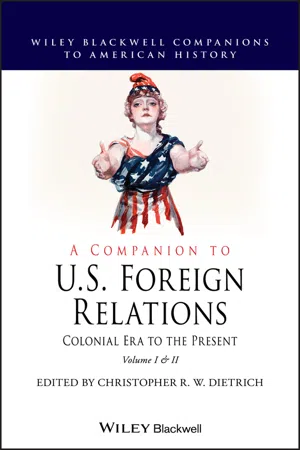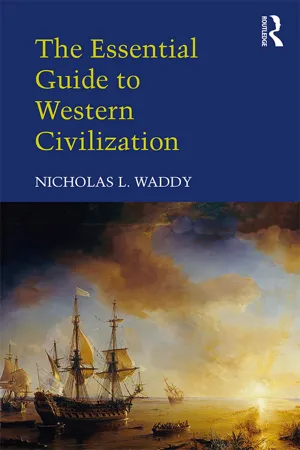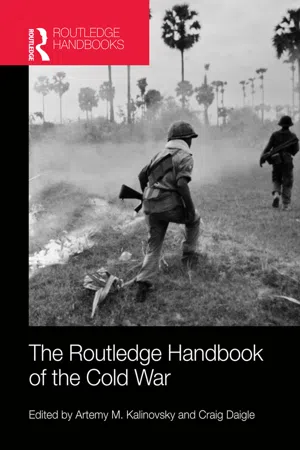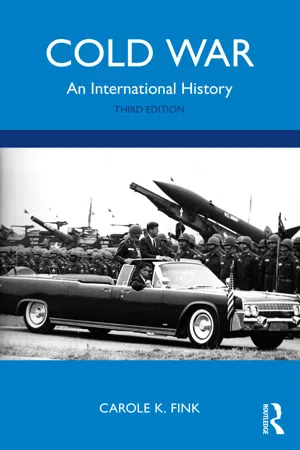History
End of Cold War
The end of the Cold War refers to the period of geopolitical and ideological transition that occurred between 1989 and 1991, marked by the collapse of the Soviet Union and the dissolution of the Eastern Bloc. This era saw a significant shift in global power dynamics, the spread of democracy, and the emergence of the United States as the world's sole superpower.
Written by Perlego with AI-assistance
Related key terms
9 Key excerpts on "End of Cold War"
- eBook - ePub
A Companion to U.S. Foreign Relations
Colonial Era to the Present
- Christopher R. W. Dietrich(Author)
- 2020(Publication Date)
- Wiley-Blackwell(Publisher)
Chapter Fifty‐One The Changing History of the End of the Cold War Sarah B. Snyder As one of the defining features of the twentieth century, much has been written about the Cold War and its end. As one scholar who recently tackled the topic put it, the end of the Cold War “has attracted a massive literature” (Service 2015). Surveying the waves of remembrances and analyses in the nearly 30 years since, we can, nonetheless, identify several key narratives. This chapter discusses four of the most important. First, considerable debate exists surrounding periodization – or, put another way, when the Cold War ended. Second, specialists on U.S. foreign relations disagree about how effective U.S. policy was in ending the Cold War. Third, and related to the second point, observers evaluate the relative contributions of key political actors quite differently. Finally, scholars are increasingly attentive to the legacies of the Cold War's end. Periodization As with the origins of the Cold War, dating when the Cold War ended, and even when its end began, has produced considerable scholarly debate. Though the historian Robert Service (2015) has argued that there is “no definable date” for the end of the Cold War, a number of key moments between 1989 and 1991 have gained proponents. Among the earliest points around which arguments have coalesced are those that align with the end of U.S. President Ronald Reagan's time in office. Former U.S. official Jack Matlock (2004) argues, “Psychologically and ideologically, the Cold War was over before Ronald Reagan moved out of the White House.” Reagan himself agreed with this chronology, telling reporters as he flew home to California following George H. W. Bush's inauguration that “The Cold War is over” (Fitzgerald 2000). For those most focused on the threat of nuclear weapons, the December 1987 Washington Summit, which was noteworthy for the signing of the Intermediate‐Range Nuclear Forces Treaty, is an appropriate endpoint - eBook - ePub
- Nicholas L. Waddy(Author)
- 2017(Publication Date)
- Routledge(Publisher)
19 The Cold War and the End of European Dominance, 1945–presentIntroduction
One of the great tragedies of the Second World War is that, for all the suffering it entailed, once it was over, oppression and the constant threat of renewed conflict persisted for many Europeans. Eastern Europeans were faced with Soviet occupation and with the replacement of their governments by communist puppet regimes. The entire world was threatened by the Cold War that emerged between the Western democracies and the Communist Bloc, led by the Soviet Union. The related threat of nuclear annihilation made the prospects for peace and stability look particularly dim.And yet Western nations and communist states avoided direct conflict, including nuclear war. The second half of the twentieth century was marked by dramatic improvements in the standard of living enjoyed by Europeans—and by most of the world’s people. The conclusion of the Cold War in 1989–91, and the collapse of communism in Eastern Europe and in its Russian heartland, paved the way for an end to the arms race and for the extension of democracy and capitalism to most of Europe’s people for the first time in history.Today, Europe is as free, peaceful, and prosperous as ever, but its role in the world is much reduced from the heady days of the nineteenth and early twentieth centuries. As this chapter and the Epilogue will make plain, Europe’s place in global affairs, and its relationship with the United States, will undoubtedly undergo further significant changes in the years ahead. Luckily, the study of European history can help illuminate the directions in which those changes are likely to lead.The Emergence of the Cold War, 1945–49
When Germany surrendered to the Allies, the future of Europe and the world as a whole was a subject of sharp disagreement. The Soviets intended to maintain control over Eastern Europe, and they believed that communist parties in Western European countries and in the Middle East would create opportunities for the further expansion of Soviet influence. The United States, Britain, and France, on the other hand, foresaw a world in which capitalist democracies would predominate. The Western Allies were divided in their opinions of European imperialism—the United States was decisively opposed—but they were united in urging the Soviets to respect the independence of all the countries of Eastern Europe. Nevertheless, none of the Western powers was prepared to fight yet another bloody war over the issue. In fact, initially it appeared that the United States might retreat into its traditional policy of isolationism and allow the Europeans to solve their own problems. One year after the end of World War II, the vast majority of American troops had been withdrawn from Europe. - eBook - ePub
The Cold War and After
Capitalism, Revolution and Superpower Politics
- Richard Saull(Author)
- 2007(Publication Date)
- Pluto Press(Publisher)
Whilst the differences between these two accounts are significant, they share a basic understanding of what needs to be accounted for. Thus, the Cold War is seen as a post-war conflict between the superpowers combing ideological and geopolitical competition and, consequently, what needs to be explained is the transformation of the bipolar relationship. As should be clear from previous chapters, my understanding of the Cold War and what needs to be explained is significantly different. Accordingly, I will offer a critique of the mainstream debate before discussing my own explanation for the collapse of Soviet-communist power and my understanding of the nature and consequences of the Cold War’s end, which will also be addressed in the final chapter.Realism and NeorealismRealist-informed explanations of the end of the Cold War focus on the general formula of the balance of power to account for change within the international system. Hence, the decisions of the Soviet leadership and developments between 1987 and 1991 are the product of power calculations and adjustments by the Kremlin in the face of preponderant US material power. Whilst more partisan commentators claim that the aggressive and confrontational policies of the Reagan administration accelerated the end of the Soviet challenge,62 most Realists emphasise the longer-term consequences of containment combined with the deep-rooted economic problems within the Soviet bloc. Consequently, the Soviets, faced with a domestic political and economic crisis, opted for strategic retrenchment by ending the Cold War through withdrawing Soviet forces from east-central Europe and ending the global competition for strategic ascendancy with the US, thus allowing for much needed economic resources to be directed towards domestic political and economic challenges.The focus is largely on the military dimensions of the Cold War with particular emphasis given to the arms control and reduction agreements between 1987 and 1991, and the withdrawal of Soviet military forces from east-central Europe. Although Realist explanations do not ignore economic and ideological developments, these are seen as being of secondary importance. Thus, the question of the ending of communist rule in east-central Europe and then the USSR, alongside Moscow’s (or more accurately the international department of the CPSUs) decision to stop supporting international revolution do not really matter. Indeed, the Cold War could have ended with the preservation of domestic communist polities, yet without the external militarised challenge to the US. - eBook - ePub
- Artemy M. Kalinovsky, Craig Daigle(Authors)
- 2014(Publication Date)
- Routledge(Publisher)
PART IX The End of the Cold War
Artemy M. Kalinovsky and Craig DaiglePassage contains an image
Explanations for the End of the Cold War
Artemy M. Kalinovsky and Craig Daigle DOI: 10.4324/9781315882284-26Few topics of Cold War history have provoked as much scholarly debate as its beginning and its end. In one camp are those who insist on the primacy of the US role in ending the conflict, and especially the vision of Ronald Reagan.1 For these scholars, it was the combination of Reagan’s vision of a world without nuclear weapons, his toughness in relations with Moscow, and his ability to articulate the superiority of the American way of life that helped to demonstrate the bankruptcy of the Soviet model. Nonsense, say others – the Cold War ended not because of anything Reagan did, but because of Soviet leader Mikhail Gorbachev’s determination to reform the Soviet Union and, in so doing, end the Cold War competition with the United States.2 International Relations theorists have been vocal as well, arguing that explanations for the end of the Cold War need to be found in structural causes – namely, Soviet economic problems and the large debts of East European states.3 Others have justly argued that any account of the Cold War’s end needs to pay equal, if not greater, attention to what took place in Europe and the actions of elites there.4 And as the chapters that follow demonstrate, one must also take into account the role of transnational institutions and movements like Solidarity in Poland and of paradigms like neoliberalism, in order to understand the end of the Cold War.One of the reasons that these debates have such resonance is because, like the debates about the Cold War’s origins, debates about its end have had and continue to have serious implications for contemporary politics. Debates about the Cold War’s origins in the 1960s and 1970s were inevitably tied to the critiques and justifications of US Cold War policies, particularly American involvement in the Vietnam War. Debates about how it ended are linked to questions about America’s place in the world, its proper relations with its allies, and even which vision of America, precisely, triumphed over communism – the New Deal vision that promised state intervention to promote equality, or the more individualistic version espoused by Ronald Reagan. Those who believe, for example, that Reagan’s toughness played a key role in ending the Cold War have used their reading of history to justify a more interventionist role for the US in the post-Cold War world. Differing interpretations of the end of the Cold War, and the terms on which it was negotiated, continue to have an impact on Russia’s relations with the United States and in Europe, including with former Soviet republics and East European satellites. - eBook - ePub
War, Peace and International Relations
An introduction to strategic history
- Colin S. Gray(Author)
- 2013(Publication Date)
- Routledge(Publisher)
14 The Cold War, I
Politics and ideologyReader's guide: The legacy of World War II. The onset of the Cold War. The course of the conflict. Soviet and US performance. Soviet failures.Introduction: from war to peace – the consequences of World War II
The Cold War has passed into history, but the nuclear bomb and the nuclear revolution are here to stay, prospectively for ever. Between them, the bomb and the political context of the Cold War nearly brought strategic history to an abrupt full stop. The human experience in its entirety might well have been concluded violently. How did this happen? And, more to the point, why? This chapter offers a fresh look at the Soviet–American Cold War of 1947–89, while the chapter that follows pays particular attention to its historically novel nuclear dimension.The events and non-events, but possible events, of the Cold War years comprise a contested history among scholars today (Westad, 2000; Herrman and Lebow, 2004). Almost everything about the Cold War is uncertain; at least, it is uncertain if one focuses on issues of motivation and causation. There is no solid consensus on why the Cold War began, who was most responsible for it, or why it concluded with barely a whimper with the loss of the will to power of the Soviet ruling elite in the late 1980s. Fortunately, the historical record provides some compensation for the deeper uncertainties. Even if one cannot be sure exactly why particular decisions were taken, one can secure an adequate grasp of who did what and when. Furthermore, one can proceed to ask and answer the strategist's question: so what? Deeds and their consequences are less mysterious than are motives.One of the themes of this text is the intimate connection between war and peace, and indeed between peace and war. Peace, at least some semblance thereof, follows war. Moreover, peace of a particular character is what a war is all about. It is easy to forget this fundamental fact amid the stress, excitement and difficulties of waging war. The Cold War was a consequence of the changes in context produced by World War II. It is vital to recognize the complex authority of context. It is not quite everything, because individuals matter. But the Stalins, Kennedys and Gorbachevs must exercise their judgement, their somewhat free will, in political, socio-cultural, economic, technological, military–strategic, geographical and historical contexts for which they are largely not responsible. - Antony Best, Jussi Hanhimaki, Joseph A. Maiolo, Kirsten E. Schulze(Authors)
- 2014(Publication Date)
- Routledge(Publisher)
Chapter Twenty The end of the Cold War and the ‘new world order’ 1980–2000CONTENTS Introduction The superpowers and the Third World The disintegration of the Soviet bloc The first Gulf War The unipolar moment: America at the apex The ‘new world order’ and ethnic conflict Conclusion Recommended readingIntroduction
Third WorldA collective term of French origin for those states that are neither part of the developed capitalist world nor the communist bloc. It includes the states of Latin America, Africa, the Middle East, South Asia and South-East Asia. Also referred to as ‘the South’ in contrast to the developed ‘North’.Although there is disagreement among historians as to when the Cold War began to fade as an international system, most recent surveys point to the decade between 1975 and 1985 as the beginning of the end. In order to grasp that argument, one needs to look beyond the superpower conflict itself and see what broader developments made the Cold War less important within international politics. Among the most important changes were those in the economic field, for example, the increase in international trade, the rise of the ‘Tiger’ economies in Asia and the decline in commodity prices all enriched the capitalist countries while impeding those of the communist bloc and its allies in the Third World . In addition, technological change, such as the rapid evolution of communications and computers, almost all of which were developed in the West, had an important effect.As the 1980s began, however, the political effects of the economic and technological changes were difficult to predict and, if anything, the challenges to the West were seen as large, if not larger, than those facing the Warsaw Pact countries. In terms of productivity and economic management, many Americans saw Japan as rapidly surpassing the United States and feared the long-term economic consequences of a less dominant American role in the global economy. The election of a right-wing Republican, Ronald Reagan, as President in 1980 reflected therefore not only the international challenges facing the United States, the breakdown of détente- eBook - ePub
Cold War
An International History
- Carole K. Fink(Author)
- 2021(Publication Date)
- Routledge(Publisher)
9 The End of the Cold War, 1985–1991
DOI: 10.4324/9780429356681-10We are not giving up our convictions, philosophy, or traditions. Neither are we calling on anyone else to give up theirs.Mikhail Gorbachev, UN Address, December 7, 1988We will not conduct ourselves in the wrong way by saying “we win, you lose.”George H.W. Bush, meeting with Václav Havel, February 21, 1990It’s nice to talk about pan-European security structures … It is a wonderful dream, but just a dream. In the meantime, NATO exists.James Baker, meeting with Mikhail Gorbachev in Moscow, May 18, 1990In his 1987 book, The Rise and Fall of the Great Powers, the Yale historian Paul Kennedy surveyed five centuries of imperial overreach. Significantly, the concluding chapters focused primarily on the United States, which, Kennedy believed, was slipping from its place as the world’s Number One. This was due not only to economic competition from Europe, Japan, and China, but primarily to the escalating cost of America’s Cold War defense establishment, which had raised the national debt in 1985 to the stratospheric figure of $1.8 trillion.However, by the winter of 1986, many observers drew an even bleaker picture of the USSR. Drained by the war in Afghanistan and by subsidies to its satellites and overseas clients; jarred by the precipitous drop in world oil and gas prices, the fall in its foreign currency earnings from trade, and declining agricultural and industrial production; crippled by its technological backwardness and rigid bureaucracy (which that year were underscored by the Chernobyl disaster); and fending off increasingly restive national minorities, the Soviet Union seemed to be facing an existential crisis.Yet no one in 1985 expected the peaceful end of the US-Soviet rivalry, the fall of the communist regimes in Eastern Europe, the reunification of Germany, and the demise of the Soviet Union – all of which occurred in the next six years. These unforeseen developments have created a lively historical debate over how and why they occurred and when the Cold War actually ended. A new generation of Cold War scholars has identified either single or multiple causes, immediate and long-term factors as well as the role of key participants beyond the US and the USSR. - eBook - ePub
- Jerald A Combs(Author)
- 2017(Publication Date)
- Routledge(Publisher)
4Further Reading
The best historical works that give primary credit to Reagan for ending the Cold War are by John Lewis Gaddis, The Cold War: A New History (2005) and Strategies of Containment: A Critical Appraisal of American National Security Policy During the Cold War (rev. and updated ed., 2005). See also Paul Lettow, Ronald Reagan and the Quest to Abolish Nuclear Weapons (2005); Beth A. Fischer, The Reagan Reversal: Foreign Policy and the End of the Cold War (1997), and Jack F. Matlock, Reagan and Gorbachev: How the Cold War Ended (2002), a memoir and history by Reagan’s ambassador to the Soviet Union.The two best and most complete histories of the end of the Cold War are Don Oberdorfer, From the Cold War to a New Era: The United States and the Soviet Union, 1983–1991 (updated ed., 1998); and Raymond Garthoff, The Great Transition: American Soviet Relations and the End of the Cold War (1994). Both give more credit to Gorbachev than to Reagan for ending the Cold War. Garthoff, who is fluent in the Russian language, has made excellent use of Soviet sources and archives. For works on the Soviet side, see Vladislav Zubok, A Failed Empire: From Stalin to Gorbachev (2007); Anatoly S. Chernyaev, My Six Years with Gorbachev (2000); Ronald Grigor Suny, The Soviet Experiment: Russia, the USSR, and the Successor States (1998); Georgi Arbatov, The System: An Insider’s Life in Soviet Politics (1992); Robert D. English, Russia and the Idea of the West: Gorbachev, Intellectuals, and the End of the Cold War (2000); and Christopher Andrew and Vasili Mitrokhin, The Sword and the Shield: The Mitrokhin Archive and the Secret History of the KGB (1999), and The World Was Going Our Way: The KGB and the Battle for the Third World - eBook - ePub
Explaining War and Peace
Case Studies and Necessary Condition Counterfactuals
- Jack Levy, Gary Goertz(Authors)
- 2007(Publication Date)
- Routledge(Publisher)
We proceed in four sections. We begin by specifying our treatment of the case and its relation to ongoing theoretical controversies. In the second section, we provide new evidence and analysis of the effects of Soviet relative decline on Moscow’s decision to retrench internationally in the 1980s. The third section establishes how changes in the structure of global production shifted the underlying terms of the Cold War rivalry and generated incentives for a Soviet policy of retrenchment and engagement with the West. In the fourth section, we bring these two material pressures together in the context of examining recent evidence on Soviet old thinkers. In the conclusion, we sum up the results of our analysis and outline the repercussions for future research.The Cold War’s end as a case study
International relations scholarship on the end of the Cold War has been hamstrung by lack of evidence as well as by poor specification of the relationship between case and theory.2 In this section, we clarify our treatment of the case. We then turn to an examination of the evidence.The ideational models
Dozens of scholars – some explicitly inspired by constructivism, others following psychological, institutional, or organizational approaches – have proposed numerous pathways through which various kinds of ideas affected the course of events. These models identify both a process by which ideas are generated and transmitted to decision-makers and a causal mechanism through which ideas affect choices.Concerning the origins and transmission of ideas, two generic processes do most of the work. The first is intellectual entrepreneurship. A crisis creates a window of opportunity by discrediting old policies and the ideas associated with them. Idea entrepreneurs then fill the gap by showing how novel ideas resolve strategic dilemmas. These entrepreneurs may be intellectuals in the various bureaucracies who feed their ideas to leaders eager for new concepts, as many scholars argue was the case in the Soviet Union in the mid-1980s (e.g., Herman 1996; Checkel 1997; Mendelson 1998; English 2000). Or the true intellectual entrepreneurs may be the top leaders themselves, as many others contend was the case with Mikhail Gorbachev and the end of the Cold War (e.g., Wendt 1992; Koslowski and Kratochwil 1994; Brown 1996; Larson 1997, chap. 6; Breslauer and Lebow 2004). Either way, these scholars maintain that although the crisis that opens the policy window may be a necessary condition of change, the response is a creative, fundamentally intellectual act that switches history onto new rails and whose explanation requires specific models. Many accounts add an important transnational element to the entrepreneurship process. Here, the origins of the ideas lie in substate intellectual communities that transmit new concepts across national borders (e.g., Knopf 1993; Risse-Kappen 1994; Evangelista 1999).
Learn about this page
Index pages curate the most relevant extracts from our library of academic textbooks. They’ve been created using an in-house natural language model (NLM), each adding context and meaning to key research topics.








